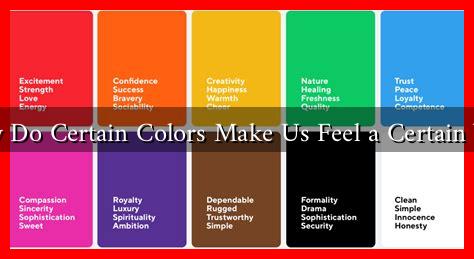-
Table of Contents
Why Do Certain Colors Make Us Feel a Certain Way?
Colors are an integral part of our daily lives, influencing our emotions, behaviors, and even decision-making processes. The psychological effects of color have been studied extensively, revealing that different hues can evoke specific feelings and reactions. This article explores the science behind color psychology, the emotional responses associated with various colors, and how these insights can be applied in real-world scenarios.
The Science of Color Psychology
Color psychology is the study of how colors affect human behavior and emotions. This field combines elements of psychology, art, and design to understand the impact of color on our mental state. Research indicates that colors can trigger emotional responses due to cultural associations, personal experiences, and even biological factors.
For instance, a study published in the journal *Color Research and Application* found that colors can influence mood and perception. The researchers noted that warm colors like red and orange tend to evoke feelings of warmth and excitement, while cool colors like blue and green are often associated with calmness and tranquility.
Emotional Responses to Colors
Different colors can elicit a range of emotions. Here are some common associations:
- Red: Often linked to passion, love, and anger. It can increase heart rates and stimulate energy levels.
- Blue: Associated with calmness, trust, and stability. It is often used in corporate branding to convey reliability.
- Yellow: Represents happiness and optimism. However, excessive yellow can lead to feelings of anxiety.
- Green: Symbolizes nature, growth, and renewal. It is known to have a calming effect and is often used in healthcare settings.
- Purple: Associated with luxury, creativity, and spirituality. It can inspire imagination and introspection.
- Black: Often linked to sophistication and elegance, but can also evoke feelings of sadness or mourning.
- White: Represents purity and simplicity. It can create a sense of space and cleanliness.
Case Studies and Real-World Applications
Understanding color psychology has practical applications in various fields, including marketing, interior design, and art therapy. Here are some notable examples:
- Marketing: Companies often use color strategically in branding. For instance, Coca-Cola uses red to evoke excitement and energy, while Facebook employs blue to promote trust and security.
- Interior Design: Designers choose colors based on the desired mood of a space. A calming blue might be used in a bedroom, while vibrant yellow could brighten a kitchen.
- Art Therapy: Therapists use color to help clients express emotions. For example, a client might choose dark colors to represent sadness, while bright colors could signify joy.
Statistics also support the significance of color in marketing. According to a study by the Institute for Color Research, up to 90% of snap judgments made about products can be based on color alone. This highlights the importance of color in consumer behavior.
Cultural Influences on Color Perception
It’s essential to recognize that color associations can vary significantly across cultures. For example:
- In Western cultures, white is often associated with purity and weddings, while in some Eastern cultures, it symbolizes mourning.
- Red is considered lucky in Chinese culture, often used in celebrations, while in some African cultures, it can represent death.
These cultural differences underscore the complexity of color perception and its emotional impact.
Conclusion
Colors play a crucial role in shaping our emotions and perceptions. Understanding the psychological effects of color can enhance our experiences in various aspects of life, from marketing to personal well-being. By recognizing how colors influence our feelings, we can make more informed choices in our environments and interactions.
In summary, the emotional responses elicited by colors are not merely subjective; they are grounded in psychological research and cultural contexts. Whether you are designing a space, creating a brand, or simply choosing an outfit, being mindful of color can lead to more positive outcomes. For further reading on color psychology, you can explore resources like the Color Psychology website.

